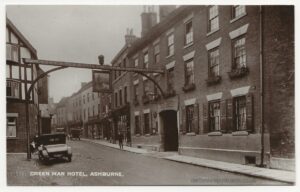“The present inn was built in 1750, and is actually the result of two separate inns joining together. The Green Man has its origins in the Jack o’the Green, the main figure in medieval May Day festivities, put to death and then restored to life to comfort his disconsolate May Queen. He was no doubt originally a nature God, but later represented the Resurrection, hence his appearance in medieval carvings in churches as a head wreathed in leaves and foliage. The present Green Man sign depicting a hunter in a green jacket is an unfortunate modern idea. The present inn derived the addition of ‘Royal’ after Queen Victoria, when still a young princess, called in for tea one day. It became well-known through its connection with James Boswell and Dr Johnson. Indeed, as Dr Johnson remarks:
“There is nothing which has yet been contrived by man, by which so much happiness is produced as by a good inn or tavern “.
They never actually stayed there, but were given a meal by Mrs Killingley, the landlady, on one of Dr Johnson’s visits to his friend Dr Taylor. Boswell records:
“I took my post-chaise from the Green Man, a very good inn st Ashbourne, the Mistress of which, a mighty civil gentlewoman, curtseying very low, presented me with an engraving of the sign of her house; to which she had sojoined in her own handwriting, an address in such singular simplicity of style that I have preserved it, pasted upon one of the boards of my original journal at this time, and shall here insert itfor the amusement of my readers. M.Killingley’s duty waits upon Mr Boswell; is exceedingly obliged to him for thisfavour, whinever he comes this way, hopes for a continuance of the same. Would Mr Boswell name the house to his extensive acquaintance. It would be a singular favour conferred on one who has it not in her power to make any other return but her most grateful thanks and sincere prayers for his happiness in time and in a blessed eternity. “
You will find the sign of the Green Man referred to in the Guinness Book of Records as the longest inn sign in the world. The full name is “The Royal Green Man and Blackamoor’s Head Commercial and Family hotel”.
Next to the Green Man was the MARQUIS OF GRANBY, named after John Manners of the Royal Regiment of Horse Guards. He was commander-in-chief of the British Army in 1766, and was known for his bravery and the way he led his cavalry against the French at the Battle of Warburg. One of his epitaphs reads:
“What conquest now will Britain boast,
Or where displays her banners?
Alas, in Granby she has lost
True courage and good manners”.
One learns that the Trustees of the Grammar School held their monthly meetings here and sipped from the fragrant bwI of punch as a due reward of their labours.
Further along the street stood one of the most important inns, the BLACKAMOORS HEAD, now the site of Wigleys shoe shop, and often shortened to the Black’s Head. The name originated from the 16th century perhaps referring to Shakespeare’s Othello. A greatly respected inn, at the beginning of the 19th century it was bought by the Landlord of the Green Man and amalgamated on to one site. In its heyday the Blackamoor Inn was used for many important events such as inquisitions, Courts, Archdeacon’s Visitations, and in 1748 even the County Assizes were held there. In the records of St Oswald’s Church there are many references, including one:
The Blackamoor’s Head was originally the site of Wigleys shoe shop, and often shortened to the Black’s Head. The name originated from the 16th century perhaps referring to Shakespeare’s Othello. A greatly respected inn, at the beginning of the 19th century it was bought by the landlord of the Green Man and amalgamated on to one site. In its heyday the Blackamoor Inn was used for many important events such as inquisitions, Courts, Archdeacon’s Visitations, and in 1748 even the County Assizes were held there. In the records of St Oswald’s Church there are many references, including one:
“1710. The performers (who had assisted in the organ opening) were entertained at dinner at the parish charge, service being ended at about 2 o’clock, and at night in the great parlour at the Sign of the Black moor’s Head. They made afine consort both of instrumental and vocall musick, and so concluded the musick of ye day”.
At the beginning of the 1800s it was known as the Holyoak Hotel, Holyoak being the name of the landlord. It was during the Napoleonic Wars, when the French prisoners-of-war were in Ashbourne that the inn was used by a French priest, Paul Roger, to celebrate divine service for his fellowcountrymen, and some of the French nobility had rooms there. Another interesting piece of history is that Sir Waiter Raleigh held land in St John Street, and could well have owned the Blackamoor.
The current painted sign shows a hunter in green wellies and a Barbour jacket – in fact the Green man referred to in the pub’s name would have been the more pagan figure of “Jack in the Green”. The carved Blackamoor head is worth a quick mention as well, if you look at it closely you will see that it is smiling as you enter Ashbourne but scowling as you leave !”


